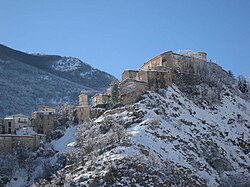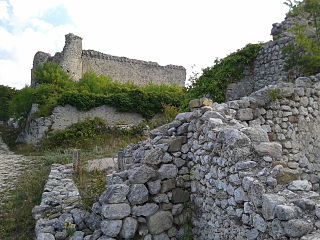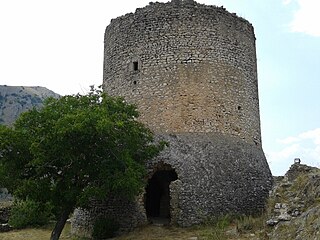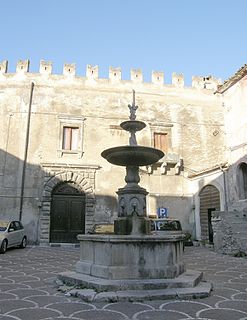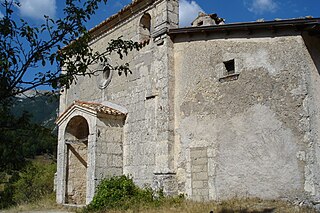This article may be expanded with text translated from the corresponding article in Italian. (May 2016)Click [show] for important translation instructions.
|
| Villalago Rocca | |
|---|---|
| Rocca di Villalago | |
| Roccacasale | |
View of the rocca | |
| Type | Castle |
| Site history | |
| Built | 8th century |
Rocca di Villalago (Italian for Villalago Rocca) is a Middle Ages rocca in Villalago, Province of L'Aquila (Abruzzo). [1]

Italian is a Romance language. Italian, together with Sardinian, is by most measures the closest language to Vulgar Latin of the Romance languages. Italian is an official language in Italy, Switzerland, San Marino and Vatican City. It has an official minority status in western Istria. It formerly had official status in Albania, Malta, Monaco, Montenegro (Kotor) and Greece, and is generally understood in Corsica and Savoie. It also used to be an official language in the former Italian East Africa and Italian North Africa, where it plays a significant role in various sectors. Italian is also spoken by large expatriate communities in the Americas and Australia. In spite of not existing any Italian community in their respective national territories and of not being spoken at any level, Italian is included de jure, but not de facto, between the recognized minority languages of Bosnia-Herzegovina and Romania. Many speakers of Italian are native bilinguals of both standardized Italian and other regional languages.

In the history of Europe, the Middle Ages lasted from the 5th to the 15th century. It began with the fall of the Western Roman Empire and merged into the Renaissance and the Age of Discovery. The Middle Ages is the middle period of the three traditional divisions of Western history: classical antiquity, the medieval period, and the modern period. The medieval period is itself subdivided into the Early, High, and Late Middle Ages.

A rocca is a type of Italian fortified stronghold, or fortress, typically located on a hilltop, beneath or on which a village or town historically clustered so that the inhabitants might take refuge at times of trouble. Generally under its owners' patronage the settlement might hope to find prosperity in better times. A rocca might in reality be no grander than a fortified farmhouse. A more extensive rocca would be referred to as a castello.
